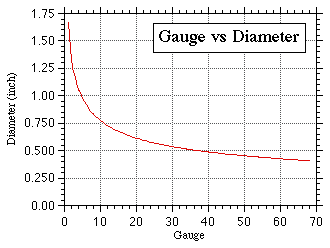Airgun Energy ( Airgun Power )
Energy in Foot Per Pound :
( velocity ( fps ) x velocity ( fps ) x projectile
weight ( grains ) ) / 450240 = ft/lbs
Energy in Joule :
( velocity ( mps ) x velocity ( mps ) x projectile
weight ( grams ) ) / 2000 = J
To convert ft/lbs to Joules = ft/lbs x 1.355817 = Joules
To convert Joules to ft/lbs = Joules / 1.355817 = ft/lbs
Velocity Via Air Pressure
Formula : V = P A t (g/m)
V = final velocity in feet/second
P = average pressure in pounds/inch squared (
psi )
A = cross-sectional area of tube in inches squared
t = time during which pressure acts
g = gravitational constant ( g = 32 feet/second )
m = mass of accelerated body in pounds
Twist Rates Of Bullet
When a bullet leave the barrel , the gravity start
to pull the bullet downward . We need a spin to bring the bullet upward
, rifling will do the work . Different rifling , rifle groove numbers effect
the upward rate , it was called Twist rates .
The most famous Twist Rates calculating fomula was
the Greenhill Formula .
There are two formula .
Formula 1 is for bullet velocity less than 2800 fps
.
Formula 1 : ( 150 x Bullet Diameter Squared ) / Bullet
Length = Required Spin
Example 1: .50 inch , Bullet length = .75 inch
Formula : ( 150 x .50 x .50 ) / .75 = 50 Spin
Formula 2 is for bullet velocity greater than 2800
fps .
Formula 2 : ( 180 x Bullet Diameter Squared ) / Bullet
Length = Required Spin
Example 2 : .50 inch , Bullet Length = .75 inch
Formula : ( 180 x .50 x .50 ) / .75 = 60 Spin
Why larger caliber can hunt larger
games?
This is true . People only use large caliber to hunt
large animals , have you seen anyone use a .177 to hunt deer or bull ?
At least , i havn't . Larger caliber have larger power transfer to the
animal . This is called the Bullet Potential ( Knock Out Power , K.O.P.
) .
The most well known formula of calculating bullet potential
is K.O. .
K.O. ( Knock Out ) method of evaluating the potential
of big game rifles, is probably the easiest and best way to tell the raw
knock out power of any given airgun and projectile.
This formula can be applied to any bullet or caliber.
Let's prove LARGER CALIBER REMAINS LARGER POWER ...................
We suppose the temperature , the humidity , the air
density , the altitude , bullet weight and velocity remains unchange .
Then we can see which caliber have more Knock Out Power .
K.O.P. Formula = ( Bullet Weight X Muzzle Velocity
X Bullet Diameter ) divided by 7000
Example 1 : .45 caliber ( inch ) , bullet weight =
370 grain , velocity = 1000 ( FPS ) .
Formula : ( 370 X 1000 X 0.45 ) / 7000 = 23.78
Example 2 : .50 caliber ( inch ) , bullet weight =
370 grain , velocity = 1000 ( FPS ) .
Formula : ( 370 X 1000 X 0.50 ) / 7000 = 26.42
Example 3 : .60 caliber ( inch ) , bullet weight =
370 grain , velocity = 1000 ( FPS ) .
Formula : ( 370 X 1000 X 0.60 ) / 7000 = 31.71
The result above have tell us that larger caliber punch
more power at the animal . And in real airgun , the bullet length is fixed
, too long will be diffcult to stablize . When we have to raise the
Knock Out Power , we have to raise another factor , Bullet Weight . We
have to use a larger caliber , and the Knock Out power will raise at a
standard ratio . That's why people use large caliber to hunt deers , bulls
and elephants .
